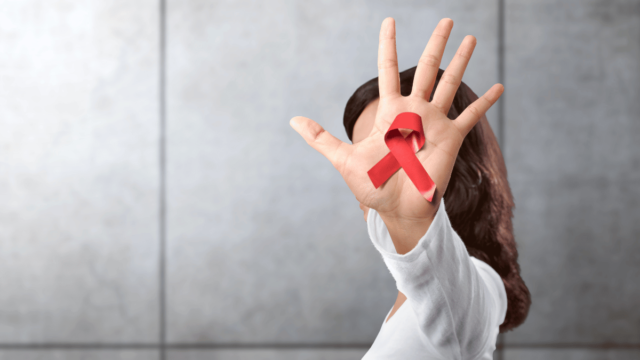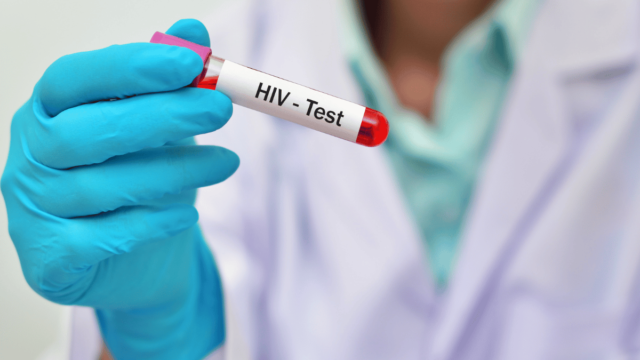HIV or Human Immunodeficiency Virus adversely affects the immune system by destroying the WBCs (White Blood Cells) that fight infection. AIDS (Acquired Immunodeficiency Syndrome) is the final stage of the HIV infection. However, not every patient infected with HIV develops AIDS. Medical advancements have made treatment of HIV possible and have come up with preventive measures of AIDS, but there is no cure for AIDS till date.
On World AIDS Awareness Day (1st December), let’s discuss the causes, HIV-induced health conditions, and HIV prevention and treatment.
5 Causes Of HIV/AIDS
- HIV transmits when body fluids that contain the virus come in touch with a permeable barrier in the body.
- It can spread when the virus comes in contact with moist tissues of certain areas of the body like semen, genitals, blood, vaginal fluids, rectal fluids, breast milk, and pre-seminal fluid.
- HIV does not get transmitted through saliva. Hence, open-mouthed kissing does not spread the infection.
- One of the leading causes of the spread of the disease is through vaginal or anal intercourse without the use of protection like condom. The lack of use of other barrier protection like pre-exposure prophylaxis (PrEP), a treatment that specialises in preventing the transmission of HIV among people with identified risk factors, can also spread the disease.
- The virus may spread through reused needles during blood transfusions, while getting a tattoo, etc. when the blood is infected.
5 Health Issues That Affect Women With HIV/AIDS
The following health conditions are common among women with HIV/AIDS:
1. STD-Related Medical Conditions
Women with HIV/AIDS are more susceptible to some STDs like Pelvic Inflammatory Disease (PID), genital herpes, and chancroid and, in such cases, these diseases are more difficult to treat.
2. Bacterial Vaginosis (BV)
Bacterial Vaginosis occurs as a result of changes in the quantity of certain types of bacteria found in the vagina. Women with HIV/AIDS are more susceptible to being diagnosed with BV and are also more difficult to treat effectively.
3. Vaginal Yeast Infections
Same as in the case of BV, vaginal yeast infections can also occur more frequently among women infected with HIV/AIDS and are also harder to treat. More specifically, recurring vaginal yeast infections, those that occur more than four times a year, are more commonly diagnosed among women with advanced HIV or AIDS.
4. Irregular Menstrual Cycle
Women with HIV are more likely to experience irregular menstruation, heavier or lighter period flow, or more severe premenstrual syndrome.
5. Cervical Cancer
Women with HIV also are at a higher risk of being diagnosed with cervical cancer. The cervical cancer that originates in the cervix, the lower and narrower part of the uterus, is usually always caused by HPV or Human Papillomavirus infection. HPV-induced cervical cancer is more common among women with HIV. This cancer being an age-defining cancer, its diagnosis indicates that the HIV infection has progressed to AIDS.
2 HIV & AIDS Treatments
The primary objective of HIV treatment, referred to as antiretroviral therapy or ART, is to reduce the amount of the virus in the body to control the spread of the disease. There is no cure for AIDS yet and it can be kept under control through effective treatment. With advancements in medical technology, the virus can now be brought under control within 6 months. However, HIV & AIDS treatment does not restrict transmission of other sexually transmitted diseases.
There are 2 types of HIV & AIDS treatments:
1. Pills
Pills are usually prescribed to HIV patients who have just started treatment as a part of HIV & AIDS therapy. Single pills and combination medications during this phase of treatment.
2. Shots
Shots may be prescribed to those who have been diagnosed of an undetectable or virally suppressed viral load for a minimum of 3 months. Shots are generally given once every month or once every alternate month, as your doctor deems fit. This is usually recommended when there is no history of its failure and there is no known allergy to the medicines that the shot contains.
2 Things You Need To Know About HIV Treatment
- Patients must undergo HIV treatment irrespective of how long they’ve been affected with the disease.
- Start treatment as soon as the disease has been diagnosed to prevent the virus from spreading further. Delaying treatment will place you at a higher risk of disease progression and its transmission to sexual partners.
HIV & AIDS Prevention Measures
Treatment as Prevention (TasP) implies taking HIV medications to prevent HIV from being sexually transmitted to partners. HIV patients who take medications for it and maintain an undetectable viral load, can live normal lives as healthy individuals. That apart, they will also not transmit HIV to their partners who do not have HIV, thus, making AIDS prevention possible.
However, for TasP to an effective AIDS therapy, patients have to take preventive measures of AIDS, which are as below:
- Take their medications as prescribed
- Go for regular visits at their doctor’s
- Take routine tests to make sure the viral load stays undetectable
FAQs
1. How can I avoid getting HIV?
Do the following to prevent yourself from getting the HIV virus:
a. Use protection while having sexual intercourse.
b. Avoid having more than one sexual partner at the same time to reduce the chances of being with a person who is affected by HIV.
c. Ensure you’re not being injected with a reused needle during blood transfusion, while getting a tattoo, and other similar situations.
2. Can I get HIV by kissing someone who is HIV positive?
No, HIV does not spread through acts like kissing, hugging, and rubbing against one another, as long as you’re not touching open sores. It also does not spread through masturbation.
3. Can latex condoms prevent HIV?
Latex condoms are very effective in stopping the spread of the HIV virus during sexual intercourse, provided you’re using it the right way. However, remember that condoms do not guarantee you 100% protection. Hence, it is often recommended that you have one HIV negative sexual partner at a time rather than multiple partners who’s sexual history you’re unaware of.
Open up like never before and participate in conversations about beauty, entrepreneurship, mental health, menstrual & sexual health, and more. Desi women, join our community NOW!



